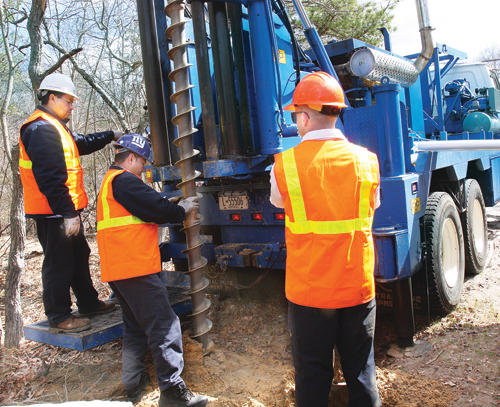Push underway to save Suffolk County drilling jobs

Employees in Suffolk County’s well-drilling unit — the same unit responsible for drilling monitoring wells near the huge plume of contaminated groundwater in Calverton — have currently found themselves on the chopping block as the county wrestles with its looming deficit.
But some legislators and environmental advocates are petitioning to save four jobs in the unit, arguing that cutting the positions saves the county comparatively little while threatening Suffolk’s ability to monitor the area’s groundwater.
“It’s kind of imperative to keep these people around since they have a job to do,” said Bill Faulk, legislative aide to Legislator Ed Romaine (R-Center Moriches). “It’s not just [Calverton]. It’s Wyndanch and Bay Shore and Huntington where they’re monitoring wells and doing work.”
Two heavy-equipment operators and one laborer from what’s now a nine-person well-drilling unit were included in the original proposed layoff list from the county. The county’s latest layoff list has added an assistant hydrogeologist and a well driller.
Grant money was found to retain one job in the unit, that of a heavy-equipment operator.
All the county’s approved layoffs — over 300 total — will take effect July 1, officials said.
Mr. Faulk said Mr. Romaine is drawing up a bill that would move all nine jobs in the well-drilling unit over to the water quality fund, funded by a voter-approved, quarter-penny sales tax. This action would take the employees’ jobs and their salaries out of the general fund.
“Whatever the cost is, we’re going to find it and try to save those jobs,” Mr. Faulk said.
The cuts collectively would save the county $300,000, Mr. Faulk said. But they would effectively eliminate one of the unit’s two crews, leaving only one to cover the entire county. The potential cost of losing those services would make any savings to the county minuscule, he said.
“Part of the county’s mission is to protect groundwater,” Mr. Faulk said. “You’d have to contract out to drill wells or abolish the people who monitor the wells.” The contracting, he said, would likely amount to about $10,000 to drill each well, plus additional costs for monitoring.
The well-drilling unit played a key role in the county’s groundwater investigation that ultimately forced the U.S. Navy to move toward cleaning up the groundwater plume contaminated with high concentrations of “volatile organic compounds.” These were believed to be from industrial cleaning compounds that had seeped into the ground at the Grumman weapons facility in Calverton.
Some contaminants are believed to date back to the 1950s.
At a time when the U.S. Navy was claiming the contaminants were being filtered out naturally as they flowed towards the Peconic River, county-drilled wells revealed the plume was much wider and ran much deeper than the Navy had asserted.
Soon after the News-Review broke the news of the county’s findings in 2009, several government officials, including U.S. Senator Charles Schumer, began to pressure the Navy to abandon its theory that the plume would take care of itself — and to take active steps to clean up the plume.
Recent Navy wells in the area have turned up levels measured at over 100 times drinking standards.
The VOCs will degrade on their own, but the Navy has proposed using a $2.3 million extraction unit to remove much of the contaminated water. In November, the Navy drilled testing wells south of the plume to see if it had reached the Peconic River.
Results of that study have not yet been released.
Wading River resident Bill Gunther, a member of the Navy’s Calverton remediation advisory committee, which has worked with Navy, state and county officials to monitor and coordinate cleanup efforts at the Grumman site, urged Suffolk County Executive Steve Bellone to keep the well-drilling unit intact.
“I know that the county is facing many difficult financial decisions, but I implore you to maintain the dedicated staff responsible for helping keep our drinking water resource safe,” Mr. Gunther wrote in a letter to Mr. Bellone. “Their ability to respond quickly and effectively to reports of potential contamination has helped to maintain the quality of this critical resource now and for future generations.”
A spokeswoman for Mr. Bellone said the county will still be able to monitor wells, despite the layoffs.
“While these cuts have necessitated reducing the size of the Office of Water Resources, Suffolk County has adequate resources to protect water quality and remains committed to its core public health mission.” said Vanessa Baird-Streeter.








